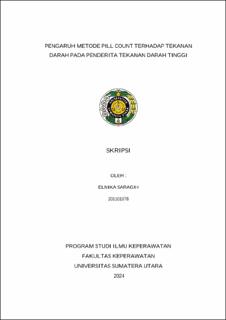Pengaruh Metode Pill Count terhadap Tekanan Darah pada Penderita Tekanan Darah Tinggi
The Effect of the Pill Count Method on Blood Pressure In Hypertension Patients

Date
2024Author
Saragih, Elnika
Advisor(s)
Harahap, Ikhsanuddin Ahmad
Metadata
Show full item recordAbstract
High blood pressure, or hypertension, is defined as a systolic blood pressure of 140 mmHg and a diastolic blood pressure of 90 mmHg. This condition is often referred to as "The Silent Killer" because it usually does not present clear symptoms but can be fatal. According to Riskesdas (2018) data, 13.3% of hypertension patients do not take their medication. Adherence to medication is crucial for controlling blood pressure. This can be evaluated through the pill count method by counting the remaining pills at the beginning and end, using a pill box as an aid, which is believed to improve patients' adherence to taking their medication. This study aims to determine the effect of the pill count method on the blood pressure of hypertension patients. The research method used is a quasy-experiment with a pretest-posttest one-group design. The study sample consisted of 33 members of the PTM posyandu in Kota Rantang Village who met the inclusion criteria, selected through total sampling. The results of the study using the Wilcoxon signed-rank text, showed a p-value of 0.014 0.05 for systolic blood pressure and a p-value of 0.006 0.05 for diastolic blood pressure, indicating a difference in both systolic and diastolic blood pressure before and after using the pill count method. Therefore, it can be concluded that the pill count method affects the blood pressure of hypertension patients in Kota Rantang Village.
Collections
- Undergraduate Theses [1278]
